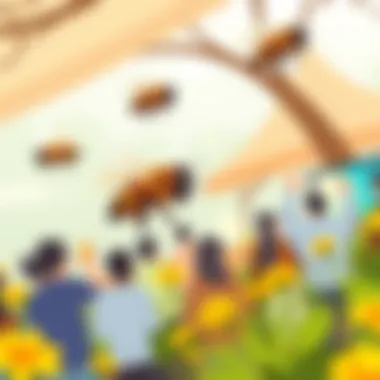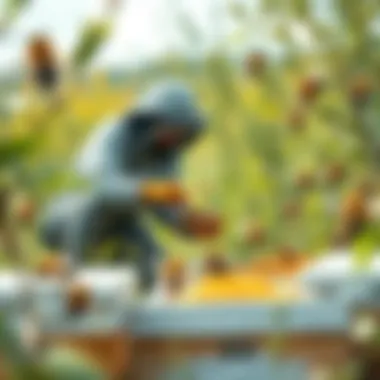Effective Strategies to Protect Bees from Decline


Intro
Bees play an indispensable role in our ecosystems, acting as pollinators that support the growth of flowers, fruits, and vegetables. Despite their importance, bee populations face a troubling decline, spurred by various factors including habitat loss, pesticide use, and climate change. This article delves into a multitude of strategies that individuals and communities can adopt to combat this decline. From informed personal actions to advocacy for better environmental policies, there is much we can do to ensure the survival of our buzzing allies.
This comprehensive guide will highlight the key points regarding the causes of bee mortality and discuss their ecological significance. Additionally, it will map out practical steps individuals can take, showcasing the collective impact of grassroots initiatives. Managing bee populations demands urgent attention, and this narrative aims to educate readers about the necessity of immediate action. We will explore methods that range from sustainable farming practices to urban gardening, thereby weaving a deeper understanding of how our choices contribute to these precious insects' survival.
Progress starts with knowledge. By recognizing the importance of bees in our food systems and ecosystems, we can cultivate a community that not only appreciates but actively protects these vital creatures. Together we can contribute to making a difference in the fight against bee decline.
Understanding Bee Population Decline
Bee populations around the world are declining at an alarming rate, and understanding the reasons behind this phenomenon is crucial. Bees play a vital role in our ecosystems, aiding in the pollination of plants, which in turn supports food production and biodiversity. Without this essential service, the effects could ripple throughout the entire food chain. Thus, recognizing the factors contributing to bee population decline is not just an academic exercise; it’s a call for action to protect our environment and, ultimately, ourselves.
Overview of Global Bee Statistics
Globally, bees are facing unprecedented challenges. According to recent studies, nearly one-third of bee species are currently at risk of extinction. Factors like habitat loss, pesticide exposure, and climate change all contribute to this distressing trend. In the United States alone, beekeepers report losing around 30% of their hives each year. Statistically, these numbers emphasize that immediate action is needed to halt this decline. Moreover, an alarming trend is that the variety of bees is shrinking. Unlike in nature, where diversity equals resilience, agricultural practices often favor just a handful of species, which makes them vulnerable to collapse.
Factors Contributing to Bee Mortality
Several interrelated factors contribute significantly to the rising bee mortality rates. Identifying these factors not only sheds light on their impact but also helps in formulating strategies to combat the decline. Here are the main culprits:
Pesticide Use
Pesticide use remains a primary driver behind bee population decline. Specifically, neonicotinoids have been singled out for their devastating effects on bees. These chemicals affect their ability to forage, navigate, and even reproduce. While pesticides are often viewed as essential for maximizing agricultural output, the hidden costs to ecosystems and food security are staggering. The challenge lies in finding a balance between agricultural needs and environmental protection. A growing number of farmers are beginning to favor integrated pest management practices that minimize pesticide use, recognizing the long-term benefits for biodiversity.
Habitat Loss
Urbanization and agricultural expansion have led to significant habitat loss for bees. As cities grow and farmland increases, floral diversity is lost, disrupting the delicate balance that bees rely on for forage. This loss isn’t just about a shortage of flowers; it’s about severing the connections in ecosystems. When bees lose their habitats, they become more susceptible to stressors and may struggle to survive. Creating bee-friendly landscapes that include wildflower corridors can help mitigate this issue, providing necessary resources for bees to thrive while maintaining biodiversity.
Climate Change
Climate change is like a thief lurking in the shadows, gradually altering the environments bees are adapted to. Increased temperatures and erratic weather patterns can impact blooming cycles and disrupt the synchronicity between bees and flowers. This misalignment means that even if bees are present, they may not find enough food when they need it. Additionally, extreme weather events like heavy rains or drought can take a toll on bee populations. Fostering practices attentive to ecological changes, such as planting climate-resilient plants, can hopefully support both the plants and the pollinators dependent on them.
Pathogens and Diseases
The health of bee populations is plagued by a myriad of pathogens and diseases. The Varroa destructor mite, for example, has wreaked havoc on honeybee colonies worldwide. This parasite weakens bees and makes them more susceptible to other diseases. In combination with pesticide exposure, the stress on colonies only escalates, leading to larger mortality rates. Supporting research into treatment options, as well as encouraging practices that promote bee health, holds promise for addressing these threats. Integrated pest management and veterinary care for bee populations are essential components to ensure that these industrious workers can survive and produce honey for communities.
Understanding these factors is pivotal for developing concrete strategies to protect and sustain bee populations. As the guardians of our ecosystems, bees deserve our attention and action.
Ecological Significance of Bees
The role that bees play in our ecosystem is nothing short of essential. As natural pollinators, they contribute significantly to biodiversity, which in turn sustains the health of our planet. This section will delve into two critical facets of bees’ ecological importance: their fundamental role in pollination and their economic significance.
Role in Pollination
Pollination is the process by which bees transfer pollen from one flower to another, enabling fertilization and reproduction in plants. This process is pivotal for maintaining plant diversity. When bees pollinate a variety of plants, they contribute to genetic diversity, which helps strengthen ecosystems and allows them to adapt to changing conditions.
Impact on Plant Diversity
The impact on plant diversity cannot be overstated. Pollinators like bees facilitate the reproduction of many flowering plants, which leads to a rich diversity of flora. This variety is crucial for cultivating a balanced ecosystem where each plant species supports others, including larger animals and microorganisms.
- Key characteristic: Increased floral abundance. This not only enhances the beauty of our natural landscapes but also provides habitat and food sources for various wildlife.
- Why it’s a beneficial choice: Diverse plant life yields a broader range of foods and environments for animals, creating a robust ecosystem.
- Unique feature: Bees tend to prefer certain types of flowers due to their shape, color, and fragrance, which means that their activities often help maintain specific plant populations.
However, plant diversity is a double-edged sword. Too much reliance on a select few types of plants can lead to declines in some species, which can disrupt ecosystem balance.
Contributions to Food Supply
Bees also have a substantial role in the contributions to food supply. Their pollination activities help produce nearly one-third of the food we consume, from fruits and vegetables to nuts and seeds. This reliance on bees underscores their significance in global agriculture.
- Key characteristic: Two-thirds of all crops rely on animal pollination, predominantly attributed to bees.
- Why it’s a beneficial choice: A diverse food supply is essential not just for human consumption but also for the health of various farmed animal species.
- Unique feature: Some crops, like almonds and blueberries, are especially dependent on bees, raising the stakes for their conservation.
The disadvantage is clear: should bee populations continue to decline, food scarcity could follow suit, threatening food security on a large scale.


Economic Importance of Bees
The economic significance of bees transcends the mere act of pollination; it touches nearly every facet of agriculture.
Effects on Agriculture
Bees directly affect the effects on agriculture, as their pollination boosts yields and enhances the quality of crops. This means higher profits for farmers and a more stable agricultural market.
- Key characteristic: Many crop industries see significant production increases thanks to pollination; for instance, the value added to farms due to bee pollination can be estimated in the billions annually.
- Why it’s a beneficial choice: Healthy bee populations translate to productive farms, leading to economic stability.
- Unique feature: The effects are not just local; beekeeping can influence international trade dynamics and local economies alike.
However, economic dependencies can often blind farmers to the declining importance of sustainable practices, which can exacerbate the issue.
Market Value of Pollinator-Dependent Crops
Finally, the market value of pollinator-dependent crops reinforces the discussion. Commodities like honey, berries, and alfalfa contribute a staggering market value largely facilitated by bee activity.
- Key characteristic: The market value of pollinator-dependent crops in the United States is estimated at a whopping $29 billion.
- Why it’s a beneficial choice: This financial backing highlights the critical need for bee conservation as a means of safeguarding agricultural profitability.
- Unique feature: The correlations between bee health and the economy are becoming increasingly evident, prompting a push for policies that enhance bee welfare.
Nevertheless, market fluctuations can affect investments in conservation, leading to potential backlash against more sustainable practices.
The health of our bees echoes through the corridors of our economy and ecosystems. Protecting them ensures a flourishing future for both our environment and our plates.
Individual Actions for Bee Conservation
The plight of bees isn’t just a distant issue that affects only the experts. Each one of us has a role to play in bee conservation. Individual actions serve as a crucial tool in promoting the health of bee populations. By making small changes in our daily lives, we can collectively create a significant impact. When individuals engage in bee-friendly activities, they help mitigate some of the myriad threats bees face today, from habitat loss to pesticides. Adopting practices that support bee survival isn't merely helpful; it anchors our broader efforts to reverse the decline of these vital creatures.
Creating Bee-Friendly Gardens
Building gardens that cater to bees isn't just about aesthetics; it’s about creating sanctuaries for these essential pollinators. The choices gardeners make can either encourage or deter bee populations.
Choosing Native Plants
When it comes to choosing plants for our gardens, opting for native species is like serving up a buffet tailored to the needs of local bee populations. Native plants have evolved together with local wildlife, so they typically provide the nectar and pollen that bees prefer. This choice not only benefits bees but also bolsters local ecosystems. Additionally, native plants often require less water and care, making them a wise choice for gardeners aiming for sustainability.
In a world where many are quick to pick non-native, exotic plants, embracing local flora allows us to kickstart a positive relationship with our environment. The disadvantage may include limited seasonal visual appeal, as some natives can have shorter bloom periods than cultivated varieties. However, few can argue against their value in fostering local insect communities.
Minimizing Pesticide Use
The second crucial step is minimizing, if not eliminating, pesticide use in our gardens. Chemical pesticides, while effective at exterminating pests, are notorious for harming bees alongside their targets. Many people might think that they can selectively use pesticides, but the risks of collateral damage are high.
Taking the organic route can sometimes require more attention and care, yet the long-term benefits to the ecosystem outweigh the perceived inconvenience. Organically grown gardens create a healthier environment and encourage a return of bees. The initial time and effort to research effective pest control alternatives may be daunting, but your perseverance can yield dividends both in terms of garden health and bee populations.
Implementing Bee Habitats
Furthermore, implementing dedicated bee habitats transforms ordinary gardens into thriving bee colonies. These habitats provide safe spaces for nesting and resting, which are critically necessary for many bee species. Hives can be incorporated in diverse forms, from bee hotels crafted from wooden blocks to lived-in flower beds full to the brim with favorite blooms.
This specific aspect, while straightforward, calls for a commitment to maintaining these habitats. Location and design matter greatly, as some bees are solitary and need particular microhabitats to thrive. On the flip side, the unique feature of these habitats is their ability to attract not just bees but other beneficial insects, enriching the local biodiversity.
Supporting Local Beekeepers
Support for local beekeepers reinforces community ties and allows us to contribute to stronger bee populations on a more personal level. When individuals commit to buying honey from local producers, they do more than just support a business; they help sustain an entire ecosystem.
Benefits of Local Honey
Local honey offers a tangible connection to our surroundings. Produced by bees that pollinate local flora, it not only supports a sustainable economy but also promotes regional ecosystem resilience. Unique flavors and health benefits can vary remarkably from region to region, and every jar tells a story of place and people.
By choosing local honey, consumers actively contribute to supporting local beekeepers. This support helps them withstand challenges like hive diseases and market pressures. However, it's essential to ensure that the honey is truly local, as not all farmers' markets are created equal.
Community Bee Initiatives
Community initiatives dedicated to bee protection can catalyze collective action. These initiatives help raise awareness and promote education on bee conservation. They often offer workshops, plantings, and volunteer opportunities that engage locals and engage them in meaningful action.
Such communal efforts can be the engine driving local engagement in bee conservation; they can inspire individuals to adopt bee-friendly practices at home. However, challenges may arise in terms of participation levels, as not every effort gains traction. Community spirit can slip through the cracks without strong leadership and initiative.


In summation, the practices of creating bee-friendly gardens and supporting local beekeepers illustrate how individual actions make a real difference. As small-scale contributions accumulate, they lay the groundwork for healthier bee populations and more resilient ecosystems.
Community and Political Engagement
Community and political engagement play a pivotal role in the battle to protect our dwindling bee populations. These initiatives are not merely about raising awareness; they are about fostering a culture of proactive stewardship and advocacy at various levels of society. When individuals and communities come together, they can create a unified voice that calls for legislative changes and enforces critical policies aimed at enhancing bee protection efforts. Involving a community enriches the conservation narrative by ensuring diverse perspectives and collective strategies, making bee activism more effective.
Advocating for Policy Change
Understanding Pollinator Protection Laws
To grasp the significance of pollinator protection laws, one must look at their foundation in environmental regulation. These laws encompass a variety of initiatives aimed at safeguarding pollinators by restricting pesticide use, protecting bee habitats, and promoting biodiversity. A key characteristic of these laws is their ability to set a legal framework that guides agricultural practices and land use, which serves not only bees but other essential wildlife as well. It's popular among environmental groups because it establishes a formal acknowledgment of the importance of pollinators in the ecosystem. However, one disadvantage can be the slow pace of policy change, often stymied by bureaucratic red tape.
Engaging with Local Governments
Engagement with local governments is instrumental in advancing bee conservation strategies. This kind of engagement means attending town hall meetings, voicing concerns directly to elected officials, or participating in community forums. A defining characteristic of interacting with local governments is the close-knit nature of these dialogues; they create opportunities for citizens to connect directly with decision-makers. It's a beneficial route for grassroots organizing because local policies can have immediate and significant impacts on local bee populations. On the flip side, navigating local politics can sometimes be challenging, as not all local governments prioritize environmental initiatives.
Education and Awareness Campaigns
Organizing Workshops
Organizing workshops focused on bee conservation can empower community members with the knowledge they need to effect change. These workshops can cover a variety of topics like starting a bee-friendly garden, understanding local bee species, and discussing legislation affecting pollinators. The key feature of these workshops is that they promote hands-on learning and engagement, providing participants with tangible skills and actions they can implement in their lives. It's a popular choice in community settings because it fosters connectivity among participants while cultivating passion for bees. However, organizing workshops necessitates time and resources that not all groups may have at their disposal.
Utilizing Social Media for Impact
In today’s digital age, social media represents a powerful tool for spreading awareness and fostering community engagement for bee conservation. Platforms like Facebook and Twitter enable advocates to reach wider audiences, share valuable content, and mobilize support for initiatives quickly. This immediacy is a key characteristic, allowing users to react in real-time to developments affecting bee populations. By utilizing social media, campaigns can tap into a younger demographic that is often more engaged online, making it a beneficial avenue for advocacy. The downside? Misinformation can spread just as rapidly, which makes it essential to ensure content accuracy to maintain credibility.
"Community and political engagement creates the bedrock for effective bee conservation. Every voice matters in the quest to protect these vital pollinators."
Technological Innovations for Bee Protection
Technological advancements hold great promise for reversing the alarming trend in bee population decline. These innovations not only provide tools for monitoring and managing bee habitats but also improve beekeeping practices, thus enhancing the overall health of bee populations. By leveraging technology, we can better understand the challenges bees face and implement solutions that support their survival. Integrating these solutions into our conservation efforts could potentially save bees and their vital ecological roles.
Using Drones for Habitat Monitoring
The use of drones for habitat monitoring has become a game changer in bee conservation. Drones equipped with high-resolution sensors can survey vast areas of land, collecting data on floral resources, habitat conditions, and potential threats to bee colonies. This real-time data can be transformative, allowing conservationists to identify which habitats are thriving and which are in decline.
- Key Benefits: Drones can cover more ground in less time compared to traditional methods.
- Cost-Effectiveness: Utilizing drones reduces labor costs associated with manual surveys.
- Precision: Drones can analyze specific areas closely, uncovering micro-habitats that may be crucial for bee survival.
The technique also allows for the exploration of remote locations, which are often overlooked in conventional research. Although the initial investment in drone technology can be steep, the long-term benefits for monitoring and protecting bee habitats undoubtedly make it a wise choice.
Advancements in Beekeeping Technology
Hive Monitoring Systems
Hive monitoring systems have become essential tools for modern beekeepers. These devices allow for continuous observation of hive conditions, providing beekeepers with vital information about their bee populations. Features such as temperature and humidity sensors help inform beekeepers about the internal environment of hives, which is critical for bee health.
- Key Characteristic: Real-time data collection helps beekeepers make timely decisions such as when to add or remove honey supers.
- Beneficial Choice: Reduced losses due to better management interventions leads to healthier colonies.
The use of these systems is only growing, with new features regularly being integrated. However, a significant consideration is the accessibility of technology and the potential learning curve for less tech-savvy beekeepers. Nevertheless, even those without a tech background can adapt and benefit from hive monitoring systems.
Varroa Mite Management
Varroa mites are among the most damaging pests affecting honeybee colonies. Technology is pivotal in managing these threats effectively. Several innovative solutions have arisen, including automated mite counting devices and treatment systems that monitor infestation levels accurately.
- Key Characteristic: These systems often utilize algorithms to predict mite loads based on collected data.
- Beneficial Choice: Proactive management helps in reducing the reliance on chemical treatments, contributing to overall bee health.
The unique attribute of these systems lies in their ability to provide a more precise assessment of mite infestations. While effective, they also present a challenge in terms of cost and maintenance. Beekeepers must weigh these factors carefully to decide if such systems align with their operational goals.
Research and Development in Bee Conservation
Research and development play pivotal roles in the ongoing efforts to stave off the decline of bee populations. This entails not only academic studies but also practical applications that ground the research in real-world settings. Understanding how bees react to environmental changes, the diseases they face, and the interactions with their ecosystems are crucial for effective conservation strategies.
Investing in R&D can uncover innovative solutions that might just pivot the narrative of bee decline. One compelling aspect of this is the use of technology to dive deeper into bee behavior and health, allowing for targeted interventions that can lead to meaningful impacts on their survival.


Current Scientific Studies
Impact of Climate on Bee Behavior
When we talk about climate impact, we aren't just spelling doom; we’re also opening windows to understanding how bees adjust their behavior. Bee foraging patterns, reproductive cycles, and even hive dynamics are influenced by temperature changes and weather variability.
A key characteristic of this study is its emphasis on adapting to changing ecosystems. For example, in regions where flowers bloom earlier due to warmer weather, bees might also shift their bloom and foraging times, creating mismatches that could jeopardize their food sources. This topic is popular for its direct link to practical applications, allowing farmers and conservationists to adjust planting schedules.
The unique feature here is that these adaptations can either be advantageous or disadvantageous. While some bees are resilient, changes can lead to loss of populations if their new habits don't align with food availability, creating a cycle of decline.
Genetic Research on Resilience
Genetic research dives into the heart of resilience, exploring the heritable traits that could help bees cope with threats like pesticides or environmental stressors. The focus here is on identifying genes that confer resistance to diseases or adaptability to fluctuating climates.
This aspect is vital because it lays the groundwork for breeding programs aimed at enhancing bee health. The positive potential of such studies is significant; if certain genetic markers for resilience can be pinpointed, bee populations could be selectively bred for these traits, offering hope for their future.
However, caution is needed; genetic manipulation could lead to unintended consequences. While the promise of enhancing the gene pool is great, it needs careful consideration of the ecological impacts.
Future Directions in Bee Studies
Focus on Collaborative Conservation Efforts
Collaboration stands out as a central focus in the future of bee conservation research. By working together across disciplines, stakeholders can combine their strengths, leading to richer insights and more effective conservation actions. Collaborative efforts not only tap into a diverse range of expertise but also foster broader community engagement in conservation issues.
The benefit of this approach is that it builds on shared knowledge and resources. Different sectors - from academia to agriculture - can put their heads together to innovate solutions. A unique feature of such collaborative efforts is the ability to implement pilot programs that might test conceptual models in real-world applications.
However, organizing these collaborative efforts can present challenges. Resources can be stretched thin, and varying agendas may lead to conflicts that could impede progress.
Including Indigenous Knowledge in Practices
Incorporating indigenous knowledge introduces a depth of understanding that has been shaped over centuries of interaction with local ecosystems. Such knowledge often includes sustainable practices that align closely with bee conservation. The respect for natural cycles and habitats embedded in indigenous practices can enrich modern conservation initiatives by harnessing traditional wisdom.
This approach is particularly beneficial because it promotes culturally appropriate strategies that resonate with local communities. Furthermore, indigenous practices often focus on long-term environmental stewardship rather than short-term fixes, making it suitable for sustainable bee protection.
The unique feature here lies in its holistic viewpoint. On the downside, ensuring that this knowledge is respected and integrated without cultural appropriation can be a delicate balance. Understanding the belief systems and traditional practices takes time and commitment.
"Research and development, when effectively collaborated with indigenous knowledge, can offer holistic strategies for conserving bees in a changing world."
Collectively, these efforts in research and development stand as an essential pillar in not only understanding bee populations better but also fostering innovative solutions rooted in scientific and traditional knowledge. As these areas continue to grow and evolve, they promise new avenues for addressing the serious challenges facing our vital pollinators.
The End: The Call to Action
In the face of dwindling bee populations, the responsibility to act rests squarely on our shoulders. The strategies outlined throughout this article lay the groundwork for what can be achieved through informed individual and collective action. Protecting bees from decline transcends mere conservation efforts; it’s a vital part of maintaining our ecosystems and ensuring food security.
While the challenges may seem daunting, every small action contributes to a grand solution. Whether it's advocating for policy changes or engaging with local communities, the ripple effect of our efforts can be tremendous. Bees are not just pollinators; they are indicators of healthy ecosystems, and their decline signifies deeper issues that must be addressed.
"To find the cure, look not only to the problem but also to the strength of our collective commitment."
Summarizing Key Takeaways
As we reflect on the information shared, it's critical to highlight the main points:
- Understanding the factors contributing to bee mortality is paramount for effective intervention.
- Community involvement in local bee initiatives bolsters the collective impact of conservation efforts.
- Advocacy for sound policies is essential in creating a protective framework for bee populations.
- Leveraging technological innovations offers fresh perspectives and solutions to challenges faced by beekeepers and bees alike.
Encouraging Ongoing Commitment
The Importance of Collective Efforts
The notion of collective efforts cannot be overstated in the quest for bee conservation. Collaborative projects create a sense of community ownership over the local environment, encouraging sustainable practices that protect bee habitats. By coming together, individuals amplify their voices, which can lead to significant changes in local agricultural practices, fostering methods that benefit both farmers and pollinators.
One key characteristic of collective efforts is their ability to unite disparate groups toward a common goal, enhancing the impact of initiatives. Community-driven programs often witness higher engagement rates because individuals feel a connection to their neighbors and surroundings. However, collective efforts require sustained commitment, which can sometimes waver in the face of challenges.
Long-Term Vision for Bee Conservation
Establishing a long-term vision for bee conservation aligns our efforts with broader environmental goals. This approach highlights the importance of viewing pollinator health as integral to biodiversity and food production. Fostering resilience in bee populations is not a one-off task; it demands ongoing investment in research and adaptive management practices. The idea here is to look beyond immediate fixes and instead, cultivate a sustainable environment for future generations.
A long-term vision encourages consistent involvement from various stakeholders, creating a shared responsibility to uphold conservation principles. This comprehensive framework guides specific actions, ensuring that efforts remain relevant and impactful in an ever-evolving ecological landscape.
In summary, these strategies advocate for cooperation and long-term planning, both essential for reversing the declining trend in bee populations. The path may not be easy, but as a united front, we can forge a brighter future for these critical pollinators.







